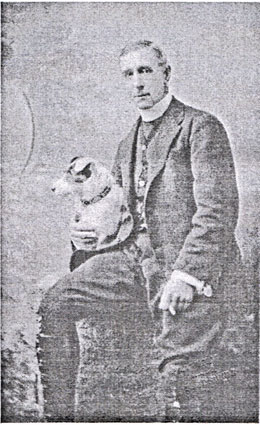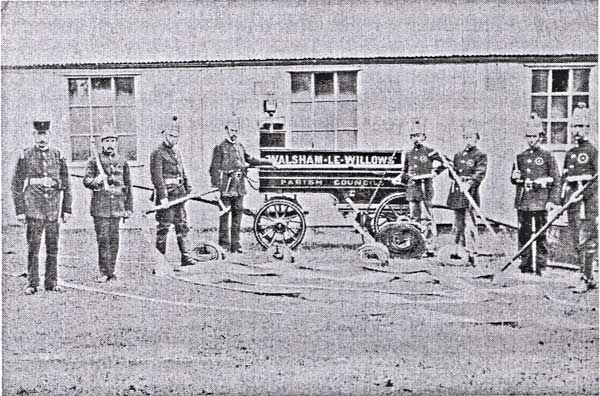A Vicar Of Walsham
The Reverend C. Ward was educated at Emanuel College Cambridge, getting his M.A. degree in 1863. A year later he was ordained and became curate of Chobham in Surrey, then of Bagshot, and then for many years Vicar of Basingstoke. A highly educated man, he became a literary critic and wrote several reviews. From 1908 he held the perpetual curacy of Walsham of Willows bringing his ‘exceedingly strong personality’ to the village.
In April 1913 a letter of complaint was received. The family of the late Mr. Robert Hunt of Clay Street in Walsham complained that they could not take his body into the church prior to burial in the cemetery. ‘As a result of our enquiry we learn that the Rev. Ward had made a rule that funerals in the parish should take place not later than the fourth day after death had occurred and if this rule was not observed then the body could not enter the church’. Robert Hunt, who was a Churchman and attended church regularly, had died on a Monday but as many of his relatives lived in London they could not get to Walsham until Saturday, and so they hoped that the rule could be waived. Reverend Ward at this time was very ill and received the request in his sick bed. However he wrote a brief note: ‘ The rule has been made because a body was once taken into the church in a decomposed state and I cannot see my way to alter this rule as similar applications could be made by others.’ The body of Mr. Hunt was therefore taken directly to the cemetery by his ‘greatly distressed’ relatives.
Two weeks later after an unsuccessful operation the Reverend Ward died. His obituary reads:
‘an exceedingly strong personality, a scholar, and an omnivorous reader with an insatiable thirst for knowledge; he possessed an extensive library of some two thousand volumes and could always be found in his study reading until late in the night. He assisted in the compilation of the 20th century New Testament and was an expert botanist. Although he took no part in politics he was a staunch Liberal.’
Parish records show he was taken to Wooton in Hampshire to be buried.
In September 1913 it was reported that a newly appointed vicar had arrived in the parish.

‘The Rev. Arthur Briggs of Moor Allerton near Leeds has now taken up residence at the Priory and commenced his duties at a well attended church service. He took for his text the words ‘be ye steadfast, immovable, and always abounding in the work of the Lord.’ He said ‘the magnificient church and lovely surroundings of Walsham-le-Willows had charmed him as soon as he saw them.’
He was to remain vicar of St. Mary’s for over 40 years.
James Turner 2009
Fire!
The first mention of a fire engine in Walsham was in 1860, when the Old Town Trust minute book mentioned that “the fire engine having become perfectly useless it was decided to preserve the other useful parts and to sell the rest”. A new one was purchased in 1865. In later years a new Merryweather fire Engine was bought by voluntary subscription, and handed over to the Old Town Trust. The Parish Council took over the running of it in 1901.

It is eight years since many villagers witnessed the terrible fire that destroyed the thatched property at Four Ashes where Brian and Jenny Blackburn lived. Fortunately these days such events are a rarity, but in years past the threat was always present. Open fires and ranges for heating and cooking, and out buildings full of hay and straw meant that it was vital for villages such as Walsham to have their own fire brigade. They saved many a property but it was often sheer luck that prevented the loss of treasured buildings.
The Cherry Tree
In Walsham in January 1874 after ‘a night of mischief and disorder’ Mr. John Clarke, innkeeper of The Cherry Tree (now a private dwelling), found that his adjoining barn containing corn was in flames. The Bury Free Press reported that the parish fire engine was ‘unfortunately out of repair – indeed a complete wreck.’ However the report states that the…
‘…useful little engine of Mr. Miller and Sons (owners of the Malting in Wattisfield Road) was paramount in saving the whole of Mr. Clarke’s premises from burning down.’
(Later that year Walsham was to get a new Merryweather Fire Engine as shown in the photograph. The water needed was pumped up out of the nearest well or out of the stream if possible.)
The Lawn
Also in January 1874 the newspaper reported:
‘At 6.30am Mrs. Hayward, who is in charge of the mansion of Mrs. Martineau (The Lawn) came downstairs to the smell of smoke in the kitchen. Mr. Adams, the gardener was called in and he found the large ten inch square beam behind the fireplace to be alight. Lately a patent cooking range had been put in but the machinery belonging to the old roasting-jack was left in the chimney. Mr. Jaggard, the builder, was to find that soot on the old apparatus had ignited and not only was the main beam completely burnt through but a beam in the floor of the above chamber was still burning. Had in not been for the early rising Mrs. Hayward, and the active steps taken by Mr. Adams the mansion would have been totally destroyed.’
The Blue Boar
In March 1879 it was reported that:
‘At 7am the hostler at the Blue Boar Inn came downstairs to attend to his duties and on going into the tap room found it to be full of smoke and saw flames. He gave alarm to his master Mr. Carpenter who instructed him to call John Stevens a member of the Walsham fire brigade. (John Stevens, a wheelwright, lived opposite the Boar in the house known as Dages.) With help from several villagers the progress of the fire was stopped. It was found that the old big fireplage had been reduced in size and soot had gathered inside on the original 13 by 8 inch beam. By the time the fire was discovered the beam and part of the mantle piece was totally burnt away. The early discovery had prevented a disastrous calamity as the premises are are joined to a thatched house.’
(This was in the present car park of The Blue Boar and adjoined other cottages.)
Clive House
In April 1913, it was reported that the residence of James Aldridge, tailor and cutter, (Clive House) had a narrow escape from fire.
‘Whilst the occupants were out of the front room a log fell from the grate igniting some clothing apparel which in turn set fire to the hearth rug and carpet. Luckily someone chanced to go into the room just as the floor-boards were beginning to burn. Disaster was averted when the flames were successfully put out but the carpets, fender, and fire irons were all spoilt.’
James Turner
Correspondence: The Floods of 1968
Review No. 47 of September 2008 has prompted the following response.
Dear Mr. Barber,
I was very interested to read the recent History Group Review article about the 1968 floods. I remember very well the rescue of Mrs Clarke as I was also on that tractor and trailer. Not only was the water very deep but it was fast flowing, the trailer tended to float behind the tractor asnd the strong current buffeted it around. It was quite a difficult job to hold the ladder steady against the upstairs window. It must have been a terrifying experience for the poor lady. We had returned to Walsham that evening but were unable to get home. The lady at the White House put us up for the night. It was only during the course of the next day that I was able to help my girlfriend and her family get back to Vine Cottage and start to clear up. The big hot air dryers from USAF Mildenhall were an enormous help in getting the houses dried out as quickly as possible, a 24-hour rota was organised and each house could use a unit for 4 hours at a time. We worked round the clock for the next two days.
With kind regards, Mike Jordan, Berndorf Austria.

